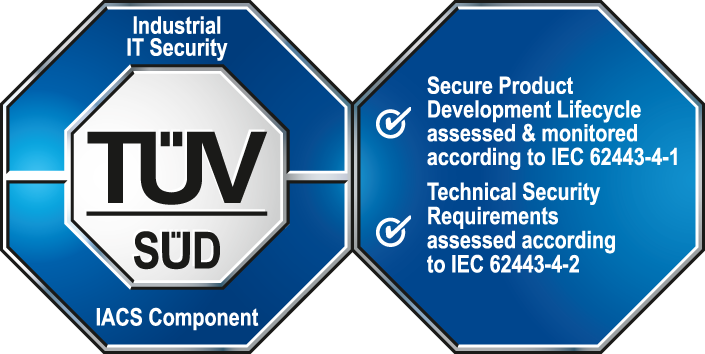Settings for specialized WebSocket servers (as used for e.g. Dashboard or Node-RED).
[wssServer] canEditPermissionBit
- Type
- int
- Default
- 3
- Range
- 1..32
Defines the permission bit which is required by an Dashboard user to edit dashboards.
[wssServer] canPublishPermissionBit
- Type
- int
- Default
- 4
- Range
- 1..32
Defines the permission bit which is required by an Dashboard user to publish dashboards.
[wssServer] dashboardSharedLicenses
- Type
- uint
- Default
- 0
- Range
- >=0
Defines the number of Dashboard Desktop licenses that can be used for mobile clients when
no more Dashboard Mobile licenses are available.
[wssServer] diskCheckDp
- Type
- string
- Default
- "_ArchivDisk"
Defines the name of the datapoint that is used to check available disk space for files
uploaded using the WebSocket server. Has to be of datapoint type
_DiskSpaceCheck. See also DP_DiskCheck in section
[data].
[wssServer] diskCheckLimit
- Type
- int
Defines the space in kB on the server disk that has to be avaiable to upload files using
the WebSocket server. If this value is not configured, the warning limit configured for the
datapoint defined in diskCheckDp is used.
[wssServer] heartbeatSeconds
- Type
- int
- Default
- 5
Specifies the interval (in seconds) in which heartbeat messages are sent from the WSS
server to all connected clients. This allows to dedect interrupted connections faster also
if no regular messages are sent. If set to 0, no heartbeat messages will be sent.
[wssServer] httpsPort
- Type
- int
- Default
- 8449
Defines the port that is used by the WebSocket server to listen for incoming WSS
connections. This port must be different from the port defined in section
[httpServer].
[wssServer] jwtWssPort
- Type
- uint
- Default
- 8449
- Range
- >0
The token issued by the HTTP server which is used by the client to authenticate with the
WSS server contains the port number where the server listens for new connections. The
default is the port number configured for and used by the WSS server. This entry allows to
define a different port number that is put into the token instead. This is necessary e.g.
when the WSS server is behind a gateway or proxy and therefore must be contacted using a
different port number.
[wssServer] resourceName
- Type
- string
- Default
- /websocket
Defines the path (part of URL) to the WebSocket server for incoming connections.
[wssServer] tokenAutoRefresh
- Type
- bool
- Default
- 0
- Range
- 0|1
If "tokenExpireWarning" is set to a value different from 0, a connection will be closed
after a warning when a token expires and the client does not send a refreshed token. A
simple automatic refresh can be activated with this entry: wif the client sends a still
valid token to the server when it receives the warning, the token will be refreshed
automatically. NB: in a typical configuration, more elaborate checks will be implemented
before a token is refreshed.
[wssServer] tokenExpire
- Type
- uint
- Default
- 600
- Range
- 5..28800
Defines the time range in seconds in which a token issued by the HTTP server is valid for
authentification at a WebSocket server. Default value is 10 minutes, possible range is from
5 seconds to 8 hours.
[wssServer] tokenExpireWarning
- Type
- uint
- Default
- 0
- Range
- 0, 5..600
The WebSocket server can close a connection automatically when the validity of the
authentification token expires. Before this happens, the WebSocket server sends a warning to
the client to allow it to updated the token. This setting defines how many seconds
(approximately) before closing the connection this warnuing is sent. If set to 0 (default),
the connection is not closed automatically and therefore no warning is sent. In this case,
the validity of the token is only verified when the connection is established.
[wssServer] useSharedWorker
- Type
- bool
- Default
- 0
- Range
- 0|1
Specifies whether frontends connecting to this server should use a SharedWorker (1) or
WebWorker (0).
[wssServer] wssServerAddress
- Type
- string
This entry defines external addresses where one (or more than one) WSS server(s) can be
reached /e.g. behind a proxy). This entry can be used more than once. The first address
will will be included in the authentification token and should correspond to the WSS
server that is running on the local system. All addresses will be used by clients to find
alternative WSS servers in case of a connection interruption.
If no such entry exists, the list of available WSS servers will be kept up-to-date
dynamically using the local WSS server addresses.



